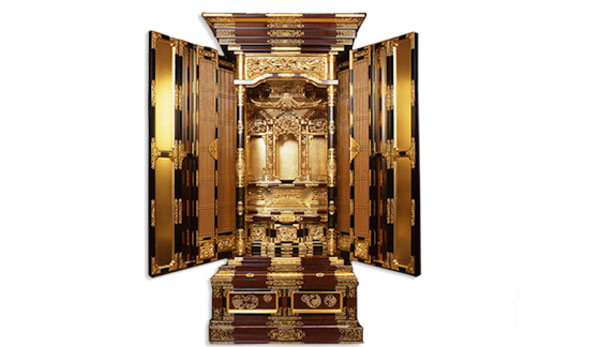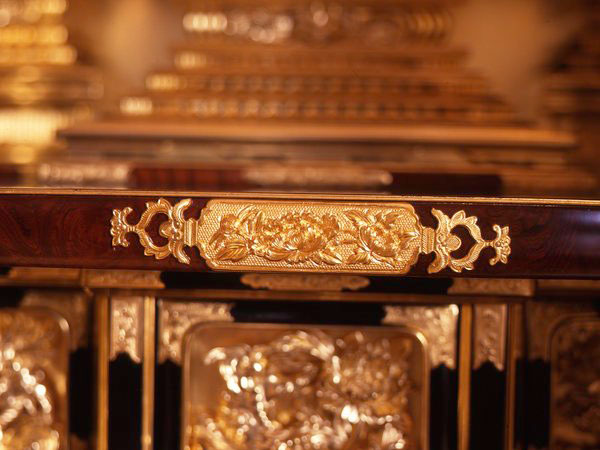
- Household Buddhist altars
- Yamagata
Yamagata Buddhist altar Yamagata butsudan
Robust appearance with impressive gold leaves designs
Unique patterns enhanced by black fittings
Description
What is Yamagata Buddhist altar ?
Yamagata Butsudan are Buddhist altars mainly made in Yamagata City, Tendo City, Obanazawa City, and Sakata City, Yamagata Prefecture, which distinguishes the prefecture as the largest center of altar production in the Tohoku region. Kichibei HOSHINO, who learned sculpture techniques in Edo (current Tokyo) during the Edo period (1603 - 1868), started to produce Buddhist altar fittings and transoms in Yamagata, setting the stage for Yamagata Butsudan. The basin structure brought about a vigorous growth of urushi work in Yamagata, and the second Kichibei, Hirotaka, started altar production with expert craftsmen in urushi work, Maki-e work and metalwork. Yamagata Butsudan is characterized by its robustness harmonized with the warmth of wood and urushi lacquer. A coating is applied to the zelkova or kalopanax woodgrain board on the front of the altar wooden base to enhance the grain effect of wood, which gives the altar an aura of beauty and magnificence. Gorgeous decorative patterns, such as a heavenly maidens, chrysanthemums and birds, grace the arabesque-designed transoms and pillars, and specially-treated black fittings are adopted as ornamental fine metal. With an ancon and square framing, the elegant inner sanctuary offers an enchanting beauty in repose. Today, the area of Yamagata Butsudan production is striving to cultivate new demands for new Buddhist altars to suit a modern house and space.
History

With abundant forest resources, woodwork took root, and high-quality urushi lacquer from the surrounding mountains paved the way for the urushi industry in Yamagata. In the Edo period (1603 - 1868), safflower trading began as the waterway traffic developed on the Mogami River, and culture and techniques were introduced from Kyoto and Osaka. As a result, the skills of artisans in Yamagata were enhanced to a higher level. Overlooking the spectacle of the three mountains of Dewa, Yamagata was a deeply religious place. Kichibei HOSHINO, who learned sculpture techniques in Edo (current Tokyo), handed those techniques down to Yamagata through production of Buddhist altar fittings and transoms, setting the prosperous stage for Yamagata Butsudan. In the Meiji period (1868 - 1912), Buddhist altar production developed as an important local industry. The production processes were divided, and specialized artisans were responsible for each process. This enabled mass production. Although our life styles and demands have changed, Yamagata Butsudan continue to produce golden Buddhist altars, maintaining its premium quality and uniqueness as the expert artisans enhance their skills while carrying on the tradition.
General Production Process

- 1. Wooden base Yamagata Butsudan undergoes seven processes where each process is professionally handcrafted by expert craftsmen. The first process is preparing the wooden base. A measuring stick is prepared and the wood is cut to designated sizes using this measuring stick. The wood is then dried thoroughly and carefully shaped. Once the wooden parts are complete, the parts to make the inside and outside of the altar are temporarily assembled. Preparing the wooden base is said to account for most of the production time, and it takes roughly a month just for this process to build a single altar.
- 2. Inner sanctuary A majestic and exquisite inner sanctuary that defines Yamagata Butsudan is made. Japanese lime, Japanese cypress or Japanese bigleaf magnolia, which are sutiable for delicate work, are used for the inner sanctuary. The small parts are combined, and the inner sanctuary with a complicated structure is temporarily assembled. This process is very delicate and time consuming. For example, placing small square bearing blocks after installing the beam would take ten days for two artisans to complete.
- 3. Wood sculpture This process is wood decor carving on transoms and pillars to add a luxurient, bright note to Yamagata Butsudan. Soft wood that is easy to carve such as Japanese linden is used. The arabesque is carved as a basic design, and mainly flowers such as tree peonies and chrysanthemums, birds such as peacocks, cranes and Chinese phoenix, or heavenly maidens are added. Sculptors often make their own chisels and knives to maximize their techniques in decor carving. Chisels and knives are carefully selected or made tailored to a design, showing adept craftsmanship.
- 4. Urushi lacquering The wooden base and carved decors are painted with urushi lacquer and polished. The painting and polishing is repeated several times for about two months. As urushi lacquer dries quicker in moist environments, the lacquered piece is dried in a special wooden cabinet with wet paper placed at the bottom.
- 5. Ornamental fine metal The unique patterns of Yamagata Butsudan are traced onto a copper or brass plate, and the distinctive and exquisite patterns are engraved using hundreds of different kinds of chisels by artisans. Engraved fine metal is finished black or gold-plated to complete an altar with a solemn atmosphere.
- 6. Maki-e Maki-e, a highly respected traditional decoration process, starts with removing fine dust while wiping the urushi-painted surface with Japanese paper, seven times. Careful pre-work cleaning yields a deep beauty. Graceful, defining patterns or designs are drawn with urushi lacquer, and then sprinkled with gold or silver powder to deliver an exquisite finish. Maki-e techniques allow the design to stand out and look radiant.
- 7. Gilding and Assembly Gold leaf is carefully layered over the urushi-painted surface to complete a golden Buddhist altar. 1,300 ultrathin gold leaves are layered on a single altar. As gold leaf is extremely susceptible to a breeze, all windows must be closed even in the midsummer, and gilding is done with utmost caution. To avoid static electricity, bamboo chopsticks are used to pick the gold leaf up. The urushi-painted, gold leaf-decorated parts are assembled and the Yamagata Butsudan is complete.
See more Household Buddhist altars
- Osaka Buddhist altar
- Hikone Buddhist altar
- Iiyama Buddhist altar
- Nagoya Buddhist altar
- Kanazawa Buddhist altar
- Kawanabe Buddhist altar
- Kyo Buddhist altar
- Hiroshima Buddhist altar
- Mikawa Buddhist altar
- Kyo Buddhist altar equipment
- Nanao Buddhist altar
- Yamagata Buddhist altar
- Yame-fukushima Buddhist altar
- Nagaoka Buddhist altar
- Sanjo Buddhist altar
- Niigata-shirone Buddhist altar
- Owari Buddhist altar equipment































































































































































































































































































